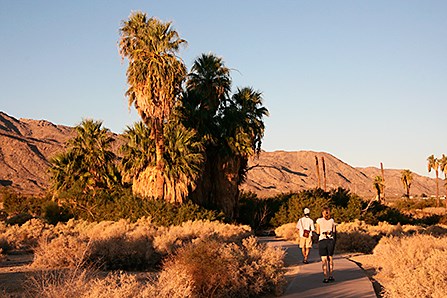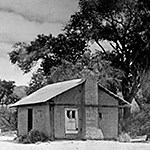
NPS/skaye In deserts the presence of water, that rarest of desert commodities, allows life to flourish and provides an oasis for natural and human activity. The Oasis of Mara is a cornerstone of the Joshua Tree National Park story. The Serrano planted 29 palm trees Native Americans, miners, & cowboys all used the oasis By 1870, prospectors attracted to California by the discoveries at Sutter's Mill had drifted into the desert looking for gold. The Anaconda Mine began operation south of the Oasis in 1874. The Lost Horse, the Desert Queen, and other claims soon followed. Trees began to be cut at the Oasis, and water siphoned away to support the growing mining operations. On the heels of the miners, cattlemen moved to the area in the 1880s to take advantage of the high desert grasslands of the Pinto and Little San Bernardino Mountains. The McHaney brothers ran an active cattle trade that was alleged to include stolen cattle that they pastured in isolated rocky coves near Hidden Valley. 
Bill McHaney became the first white settler to live at the Oasis in 1879. Later, Jack Rankin and Billy Neaves built an adobe house at the east end of the Oasis. It stood for over 40 years and served as a residence, a stage line stop, and a meeting place. The Barker and Shays Cattle Company dug a 600-gallon well around 1900 for use by the growing population. A 1902 census found 37 Serrano and Chemehuevi living at the Oasis. As more non-Indians arrived, the Indian families began to drift away, and by 1913, the Serrano and Chemehuevi were all gone. Following World War I, the town of Twentynine Palms saw an influx of veterans suffering from the effects of gas inhalation, drawn to the area by its warm, arid climate. The establishment in 1936 of a vast stretch of the desert above town as Joshua Tree National Monument drew more people to the area. The Twentynine Palms Corporation donated the Oasis of Mara to the National Park Service in 1950 to use as its headquarters. Today, the site still attracts people for its cultural history and natural beauty. Joshua Tree National Park works with the 15 traditionally associated tribal communities as the original stewards of the land. We are grateful to have the opportunity to work with the indigenous people in this place. We pay our respect to the people past, present and emerging who have been here since time immemorial.
|
Last updated: April 23, 2024
